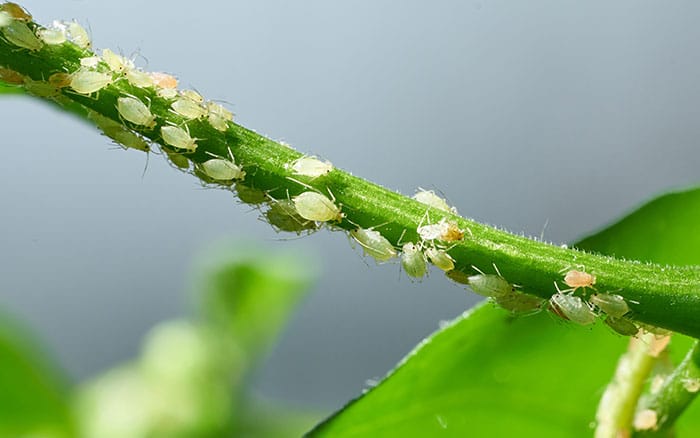Now that the busy growing season has come to an end it’s a good idea to take a closer look inside your greenhouse to check for evidence of pests which might be planning on overwintering in the cosy atmosphere that being under glass provides!
Luckily most greenhouse pests are quite easy to spot and here’s a guide to the most common pests and how to remove and deter them
Glasshouse whitefly
First up is one of the major greenhouse pests. Very small and white; they tend to congregate together on plants.
An easy way to tell if they’ve taken up residence is to simply walk the length of the greenhouse brushing leaves on all the plants as you pass them. If whitefly have taken up residence, brushing the leaves should result in groups of them flying up in the air together.
If the infestation of whitefly has been there for some time, you’ll notice some of the plant leaves may be coated in a sticky substance (known as honeydew).
There may also be evidence of black, sooty mould on the leaves.
Wash all traces of both honeydew and black sooty mould off the plant using warm water.
If you see any of these symptoms, it’s ideal to buy a biological control treatment. One of the most effective is the parasitic wasp, Encarsia, which feeds on whitefly and is a good way of controlling them. Most good Garden Centres will stock them.
Some people believe that having pots of strong scented plants like thyme and lavender mixed in with the other plants helps to deter whiteflies, which may be worth experimenting with.

Scale insect
These insects are easy to spot once you know where to look for them. They are curved and brown and tend to congregate and glue themselves along stems and underside leaves.
Sprays, organic and non-organic, can’t usually penetrate their thick, waxy, outer covering. So, the best way to control them is grit your teeth and pick them off. In very bad cases it might be easier to prune and dispose of the badly affected stems.
Scale insects thrive on plants that are stressed, especially plants that haven’t been watered in dry, warm environments. So, keep your plants adequately watered and stress free. Liquid seaweed added to the watering can when watering, can act as a health tonic for plants.

Red spider mite
These are tiny little mites, almost invisible to the naked eye. So, they’re usually only identified when they’ve spun a fine webbing over the plant leaves, usually accompanied by the leaf developing speckles on it, becoming limp and turning a paler colour.
Biological control is, again, the best way of controlling them once discovered. There are packs of tiny predatory mites available to buy from garden centres. One of the most common is Phytoseiulus, but you won’t need to remember that name. Instead, just ask for predatory mites to control spider mite.
Spider mites love a warm, still, dry, atmosphere. Therefore, the best ways to avoid them taking up occupation is to keep air circulating at all times of the year with open windows for part of the day. On warm, sunny days, damp down the greenhouse floor. This means pouring a watering can full of water along the length of the floor/paving to raise the humidity inside the greenhouse.

Slugs and snails
Most of us are familiar with the ‘snail trail’ left by slugs and snails as they munch their way along the rows of plants. Look out too for the munched holes appearing on the leaves.
They love a warm, dark, damp environment so best to do any watering in the morning rather than last thing.
It’s quite common for gardeners to go into the greenhouse at night armed with a torch and a bucket to locate and remove the offenders.
Check underneath the staging as well as in corners and under pots, all well-known hiding places for them.
Check boxes, seed trays and under the rims, as those are other favourite hiding places.
Wash any empty pots stored in the greenhouse with soapy water, as this should help remove any eggs that may have been laid on or in them.

Vine weevil
Vine weevil beetles love to lay their eggs in pots containing compost. It’s the vine weevil larvae that do the most damage as they munch on the roots of pot plants. If they’re not caught in time, will kill the plant.
Biological controls in the form of nematodes are available to water onto the soil. But these nematodes don’t survive in colder conditions, however it’s worth trying at this time of the year for use on greenhouse plants.
Do check all your pots as well. Lift the pot, gently tapping the bottom and sides to loosen the contents. Then remove the soil and plant from the pot.
Before doing this, have either an old tarpaulin or empty plastic compost sacks laid out on the floor to contain any loose compost.
The other reason for doing this is, if vine weevil larvae are present, the soil is usually very loose, and the plant will often come away from the soil leaving the munched roots behind in it.
If you find vine weevil larvae, you must dispose of the soil separately – not on your compost heap. Then, thoroughly wash the pot before reusing.
You may be able to rescue the plant, but to do so you’ll need to wash off every particle of soil from the roots and repot in fresh compost. If you’re lucky the plant will regrow.


Leave A Comment